Report on Employability Skills in the Travel and Tourism Sector
VerifiedAdded on 2024/06/28
|24
|4962
|81
Report
AI Summary
This report provides an overview of employability skills within the travel and tourism sector, focusing on the Travelodge organization. It discusses the development of responsibilities and performance objectives, evaluation of effectiveness, and recommendations for improvement, including motivational techniques. The report addresses work-based problems, communication styles, and time management strategies. Team dynamics and the roles people play in achieving shared goals are analyzed, with suggestions for alternative task completion methods. Furthermore, the report evaluates tools and methods for problem-solving, develops a strategy for resolving labor turnover, and assesses the potential impact of implementing the strategy on the business. The document concludes with a summary of key findings and recommendations.
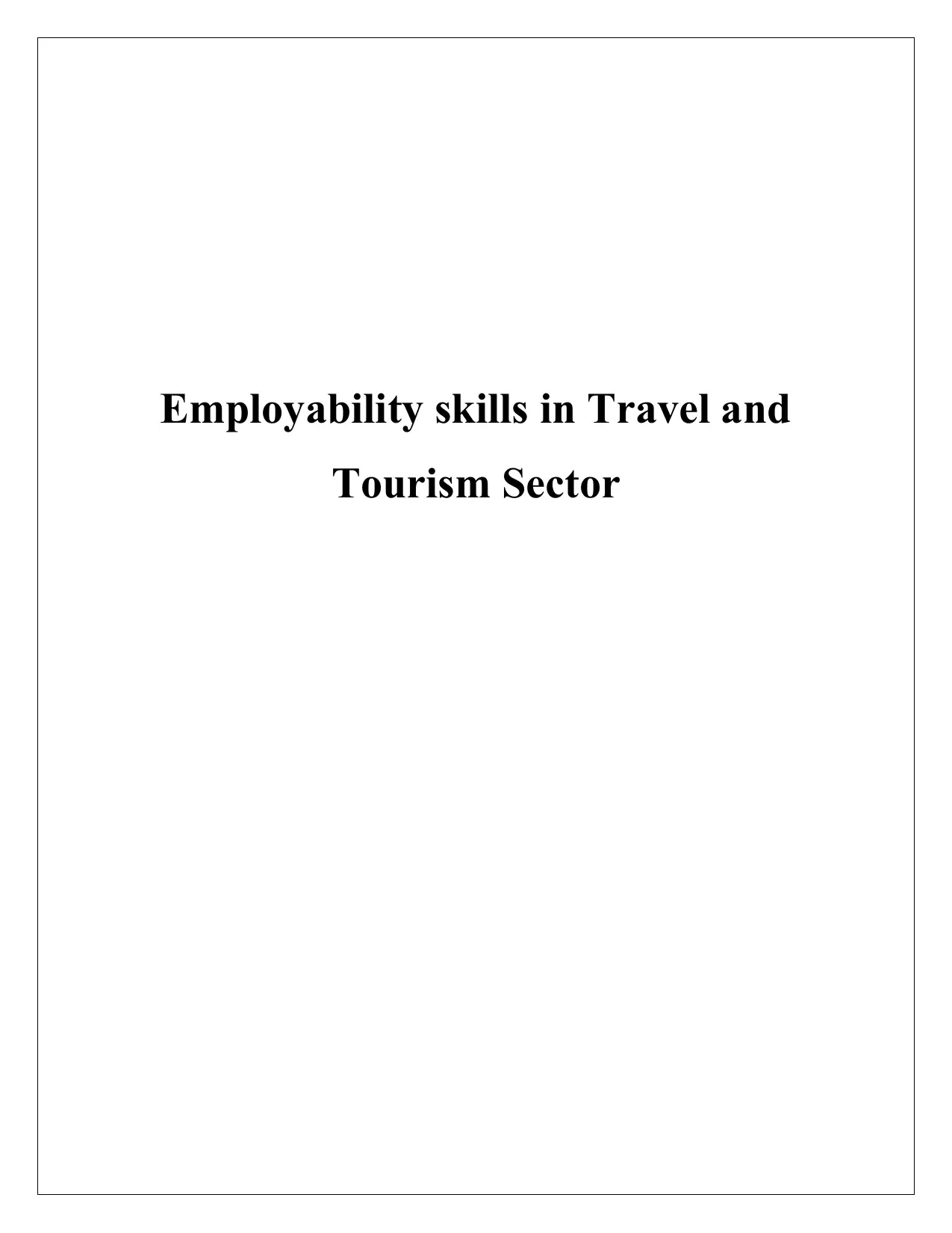
Employability skills in Travel and
Tourism Sector
Tourism Sector
Paraphrase This Document
Need a fresh take? Get an instant paraphrase of this document with our AI Paraphraser

TABLE OF CONTENTS
Introduction......................................................................................................................................1
LO1.................................................................................................................................................. 2
P1.1 Develop a set of own responsibilities and performance objectives.....................................2
P1.2 Evaluate own effectiveness against defined objectives.......................................................3
P1.3 Make recommendations for improvement...........................................................................4
P1.4 Review how motivational techniques can be used to improve quality of performance......5
LO2.................................................................................................................................................. 7
P2.1 Develop solutions to work-based problems........................................................................ 7
P2.2 Communicate in a variety of styles and appropriate manner at various levels...................8
P2.3 Identify effective time-management strategies...................................................................9
LO3................................................................................................................................................ 10
P3.1 Explain the roles people play in a team and how they can work together to achieve shared
goals........................................................................................................................................... 10
P3.2 Analyse team dynamics..................................................................................................... 12
P3.3 Suggest alternative ways to complete tasks and achieve team goals................................13
LO4................................................................................................................................................ 14
P4.1 Evaluate tools and methods for developing solutions to problems...................................14
P4.2 Develop an appropriate strategy for resolving the problem of labour turnover in an
organisation................................................................................................................................15
P4.3 Evaluate the potential impact on the business of implementing the strategy....................16
Conclusion..................................................................................................................................... 17
References......................................................................................................................................18
Introduction......................................................................................................................................1
LO1.................................................................................................................................................. 2
P1.1 Develop a set of own responsibilities and performance objectives.....................................2
P1.2 Evaluate own effectiveness against defined objectives.......................................................3
P1.3 Make recommendations for improvement...........................................................................4
P1.4 Review how motivational techniques can be used to improve quality of performance......5
LO2.................................................................................................................................................. 7
P2.1 Develop solutions to work-based problems........................................................................ 7
P2.2 Communicate in a variety of styles and appropriate manner at various levels...................8
P2.3 Identify effective time-management strategies...................................................................9
LO3................................................................................................................................................ 10
P3.1 Explain the roles people play in a team and how they can work together to achieve shared
goals........................................................................................................................................... 10
P3.2 Analyse team dynamics..................................................................................................... 12
P3.3 Suggest alternative ways to complete tasks and achieve team goals................................13
LO4................................................................................................................................................ 14
P4.1 Evaluate tools and methods for developing solutions to problems...................................14
P4.2 Develop an appropriate strategy for resolving the problem of labour turnover in an
organisation................................................................................................................................15
P4.3 Evaluate the potential impact on the business of implementing the strategy....................16
Conclusion..................................................................................................................................... 17
References......................................................................................................................................18
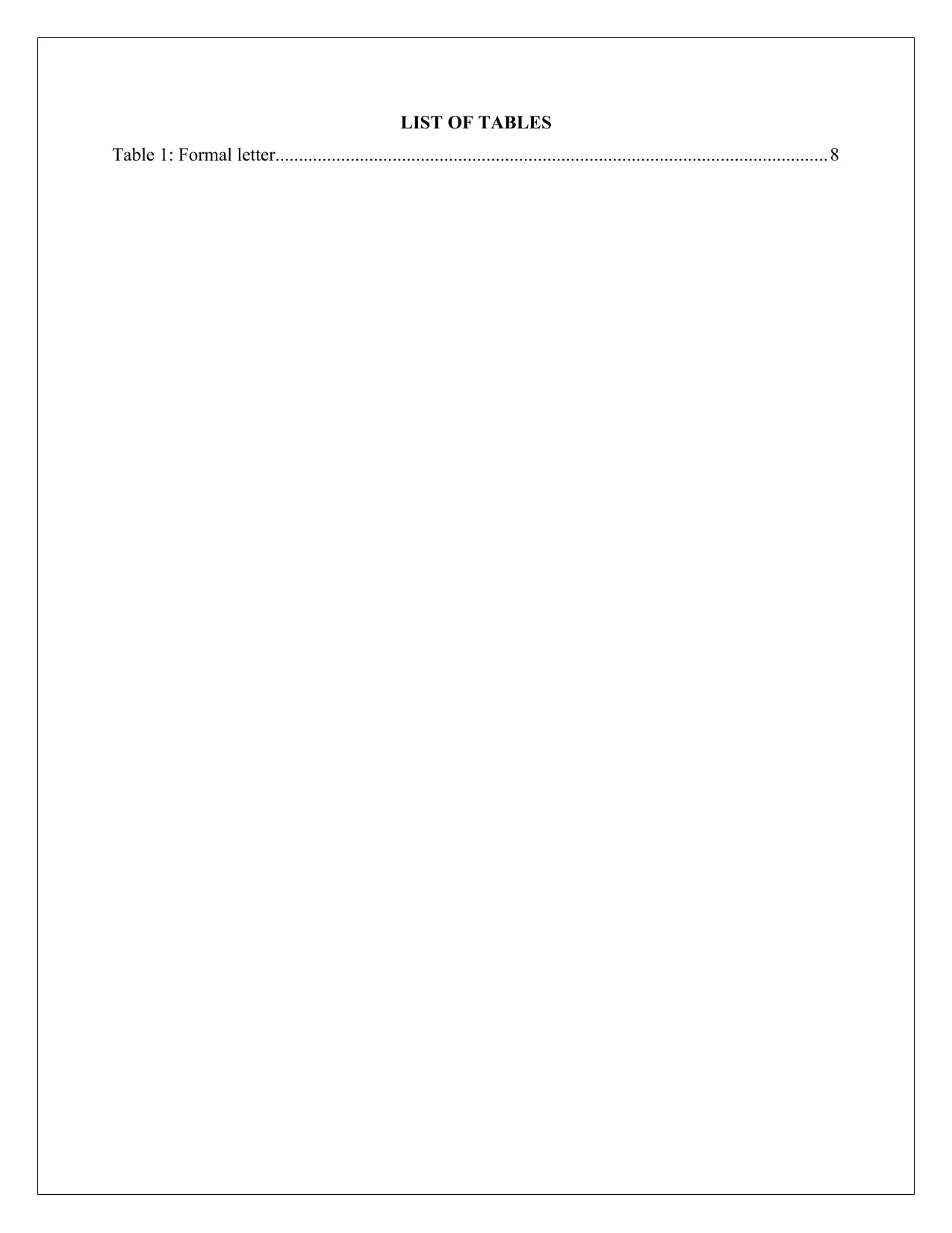
LIST OF TABLES
Table 1: Formal letter...................................................................................................................... 8
Table 1: Formal letter...................................................................................................................... 8
⊘ This is a preview!⊘
Do you want full access?
Subscribe today to unlock all pages.

Trusted by 1+ million students worldwide
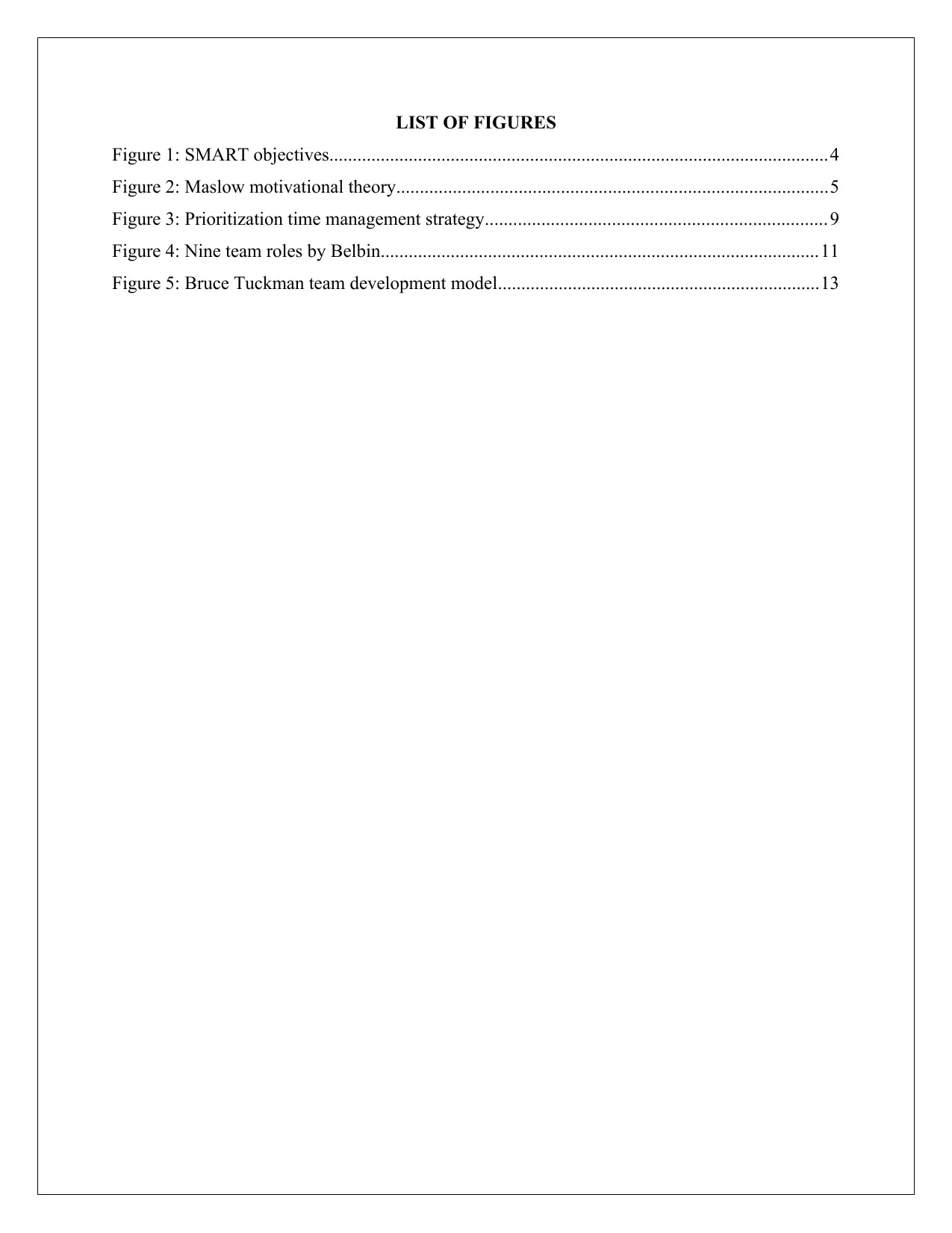
LIST OF FIGURES
Figure 1: SMART objectives...........................................................................................................4
Figure 2: Maslow motivational theory............................................................................................5
Figure 3: Prioritization time management strategy......................................................................... 9
Figure 4: Nine team roles by Belbin..............................................................................................11
Figure 5: Bruce Tuckman team development model.....................................................................13
Figure 1: SMART objectives...........................................................................................................4
Figure 2: Maslow motivational theory............................................................................................5
Figure 3: Prioritization time management strategy......................................................................... 9
Figure 4: Nine team roles by Belbin..............................................................................................11
Figure 5: Bruce Tuckman team development model.....................................................................13
Paraphrase This Document
Need a fresh take? Get an instant paraphrase of this document with our AI Paraphraser
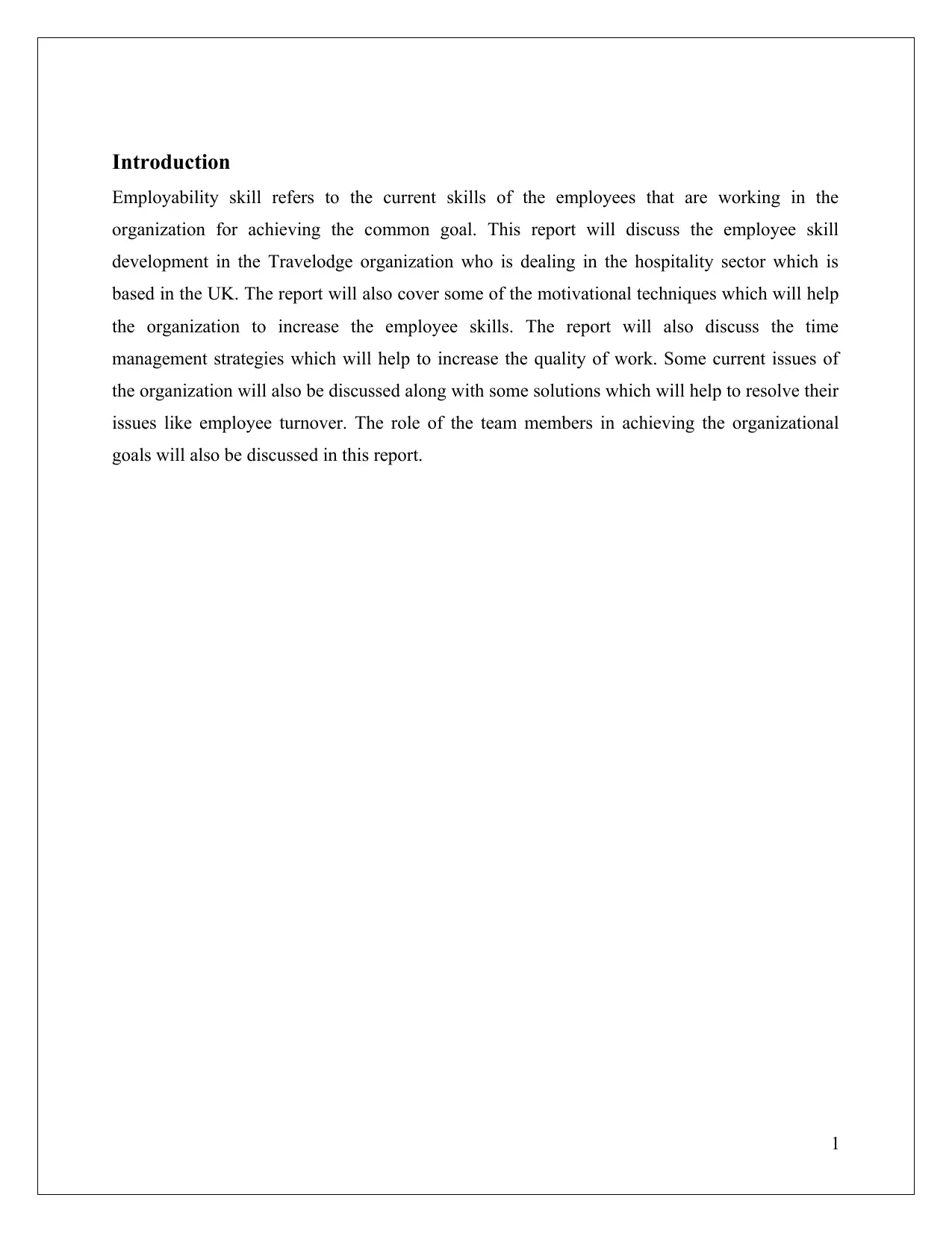
Introduction
Employability skill refers to the current skills of the employees that are working in the
organization for achieving the common goal. This report will discuss the employee skill
development in the Travelodge organization who is dealing in the hospitality sector which is
based in the UK. The report will also cover some of the motivational techniques which will help
the organization to increase the employee skills. The report will also discuss the time
management strategies which will help to increase the quality of work. Some current issues of
the organization will also be discussed along with some solutions which will help to resolve their
issues like employee turnover. The role of the team members in achieving the organizational
goals will also be discussed in this report.
1
Employability skill refers to the current skills of the employees that are working in the
organization for achieving the common goal. This report will discuss the employee skill
development in the Travelodge organization who is dealing in the hospitality sector which is
based in the UK. The report will also cover some of the motivational techniques which will help
the organization to increase the employee skills. The report will also discuss the time
management strategies which will help to increase the quality of work. Some current issues of
the organization will also be discussed along with some solutions which will help to resolve their
issues like employee turnover. The role of the team members in achieving the organizational
goals will also be discussed in this report.
1
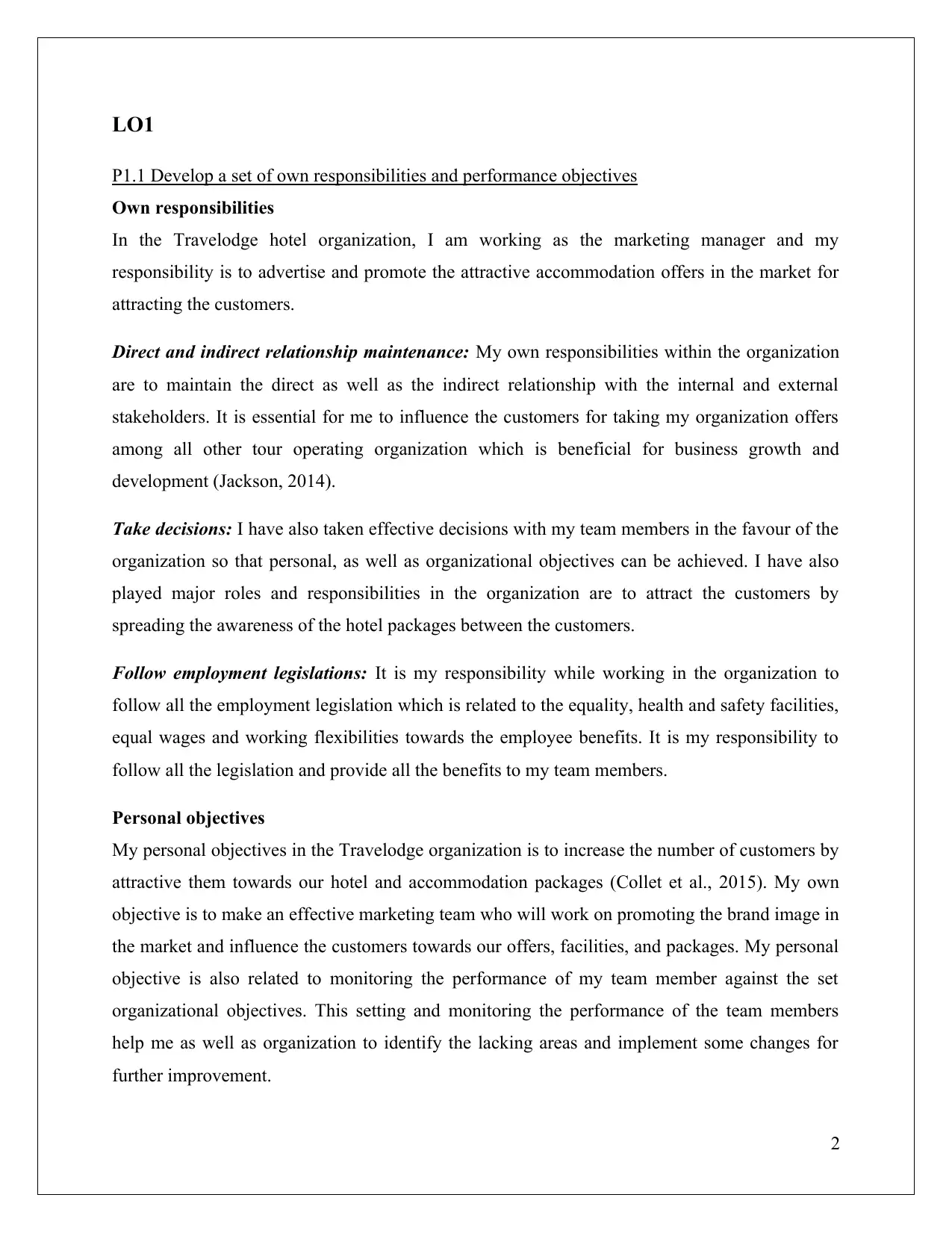
LO1
P1.1 Develop a set of own responsibilities and performance objectives
Own responsibilities
In the Travelodge hotel organization, I am working as the marketing manager and my
responsibility is to advertise and promote the attractive accommodation offers in the market for
attracting the customers.
Direct and indirect relationship maintenance: My own responsibilities within the organization
are to maintain the direct as well as the indirect relationship with the internal and external
stakeholders. It is essential for me to influence the customers for taking my organization offers
among all other tour operating organization which is beneficial for business growth and
development (Jackson, 2014).
Take decisions: I have also taken effective decisions with my team members in the favour of the
organization so that personal, as well as organizational objectives can be achieved. I have also
played major roles and responsibilities in the organization are to attract the customers by
spreading the awareness of the hotel packages between the customers.
Follow employment legislations: It is my responsibility while working in the organization to
follow all the employment legislation which is related to the equality, health and safety facilities,
equal wages and working flexibilities towards the employee benefits. It is my responsibility to
follow all the legislation and provide all the benefits to my team members.
Personal objectives
My personal objectives in the Travelodge organization is to increase the number of customers by
attractive them towards our hotel and accommodation packages (Collet et al., 2015). My own
objective is to make an effective marketing team who will work on promoting the brand image in
the market and influence the customers towards our offers, facilities, and packages. My personal
objective is also related to monitoring the performance of my team member against the set
organizational objectives. This setting and monitoring the performance of the team members
help me as well as organization to identify the lacking areas and implement some changes for
further improvement.
2
P1.1 Develop a set of own responsibilities and performance objectives
Own responsibilities
In the Travelodge hotel organization, I am working as the marketing manager and my
responsibility is to advertise and promote the attractive accommodation offers in the market for
attracting the customers.
Direct and indirect relationship maintenance: My own responsibilities within the organization
are to maintain the direct as well as the indirect relationship with the internal and external
stakeholders. It is essential for me to influence the customers for taking my organization offers
among all other tour operating organization which is beneficial for business growth and
development (Jackson, 2014).
Take decisions: I have also taken effective decisions with my team members in the favour of the
organization so that personal, as well as organizational objectives can be achieved. I have also
played major roles and responsibilities in the organization are to attract the customers by
spreading the awareness of the hotel packages between the customers.
Follow employment legislations: It is my responsibility while working in the organization to
follow all the employment legislation which is related to the equality, health and safety facilities,
equal wages and working flexibilities towards the employee benefits. It is my responsibility to
follow all the legislation and provide all the benefits to my team members.
Personal objectives
My personal objectives in the Travelodge organization is to increase the number of customers by
attractive them towards our hotel and accommodation packages (Collet et al., 2015). My own
objective is to make an effective marketing team who will work on promoting the brand image in
the market and influence the customers towards our offers, facilities, and packages. My personal
objective is also related to monitoring the performance of my team member against the set
organizational objectives. This setting and monitoring the performance of the team members
help me as well as organization to identify the lacking areas and implement some changes for
further improvement.
2
⊘ This is a preview!⊘
Do you want full access?
Subscribe today to unlock all pages.

Trusted by 1+ million students worldwide
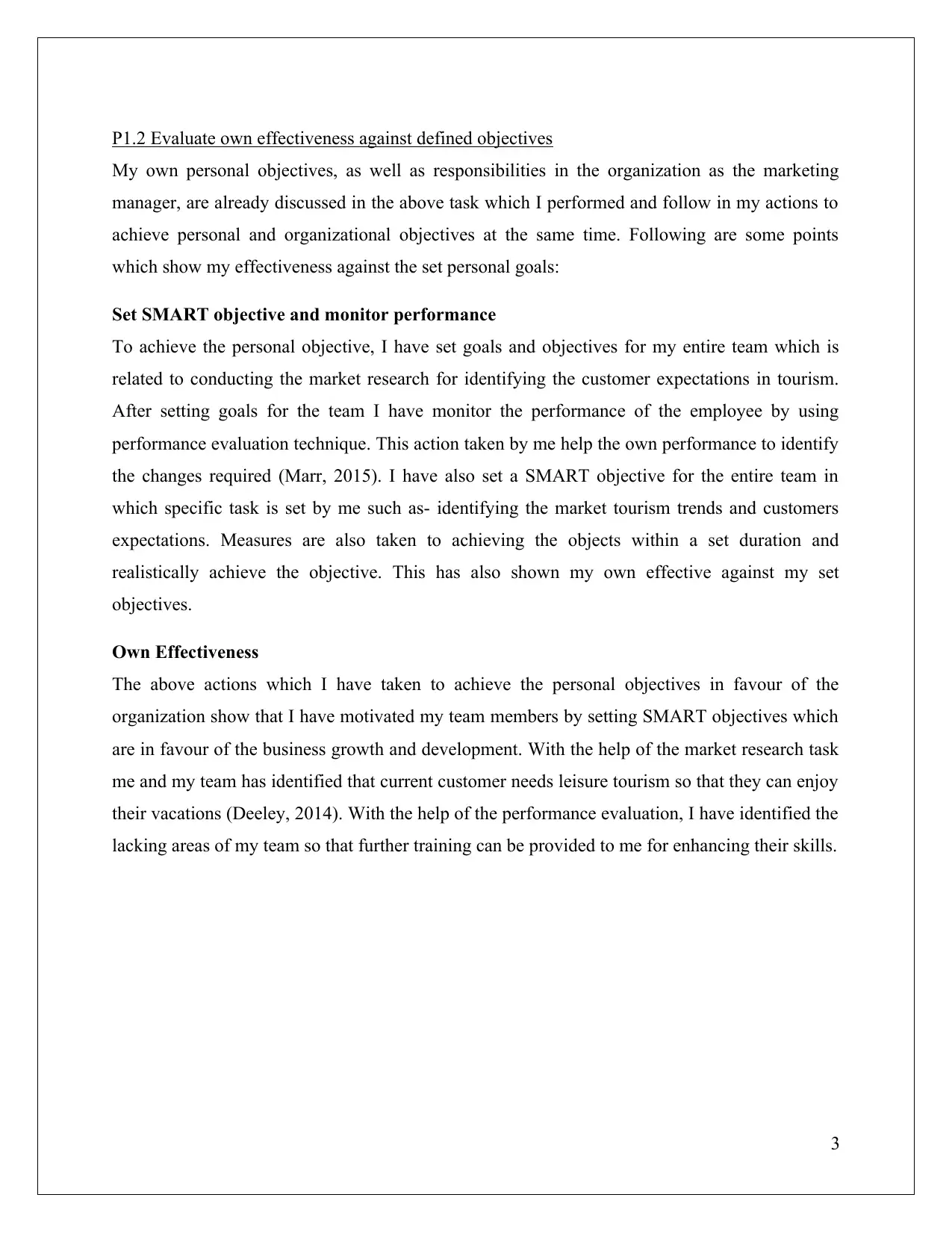
P1.2 Evaluate own effectiveness against defined objectives
My own personal objectives, as well as responsibilities in the organization as the marketing
manager, are already discussed in the above task which I performed and follow in my actions to
achieve personal and organizational objectives at the same time. Following are some points
which show my effectiveness against the set personal goals:
Set SMART objective and monitor performance
To achieve the personal objective, I have set goals and objectives for my entire team which is
related to conducting the market research for identifying the customer expectations in tourism.
After setting goals for the team I have monitor the performance of the employee by using
performance evaluation technique. This action taken by me help the own performance to identify
the changes required (Marr, 2015). I have also set a SMART objective for the entire team in
which specific task is set by me such as- identifying the market tourism trends and customers
expectations. Measures are also taken to achieving the objects within a set duration and
realistically achieve the objective. This has also shown my own effective against my set
objectives.
Own Effectiveness
The above actions which I have taken to achieve the personal objectives in favour of the
organization show that I have motivated my team members by setting SMART objectives which
are in favour of the business growth and development. With the help of the market research task
me and my team has identified that current customer needs leisure tourism so that they can enjoy
their vacations (Deeley, 2014). With the help of the performance evaluation, I have identified the
lacking areas of my team so that further training can be provided to me for enhancing their skills.
3
My own personal objectives, as well as responsibilities in the organization as the marketing
manager, are already discussed in the above task which I performed and follow in my actions to
achieve personal and organizational objectives at the same time. Following are some points
which show my effectiveness against the set personal goals:
Set SMART objective and monitor performance
To achieve the personal objective, I have set goals and objectives for my entire team which is
related to conducting the market research for identifying the customer expectations in tourism.
After setting goals for the team I have monitor the performance of the employee by using
performance evaluation technique. This action taken by me help the own performance to identify
the changes required (Marr, 2015). I have also set a SMART objective for the entire team in
which specific task is set by me such as- identifying the market tourism trends and customers
expectations. Measures are also taken to achieving the objects within a set duration and
realistically achieve the objective. This has also shown my own effective against my set
objectives.
Own Effectiveness
The above actions which I have taken to achieve the personal objectives in favour of the
organization show that I have motivated my team members by setting SMART objectives which
are in favour of the business growth and development. With the help of the market research task
me and my team has identified that current customer needs leisure tourism so that they can enjoy
their vacations (Deeley, 2014). With the help of the performance evaluation, I have identified the
lacking areas of my team so that further training can be provided to me for enhancing their skills.
3
Paraphrase This Document
Need a fresh take? Get an instant paraphrase of this document with our AI Paraphraser
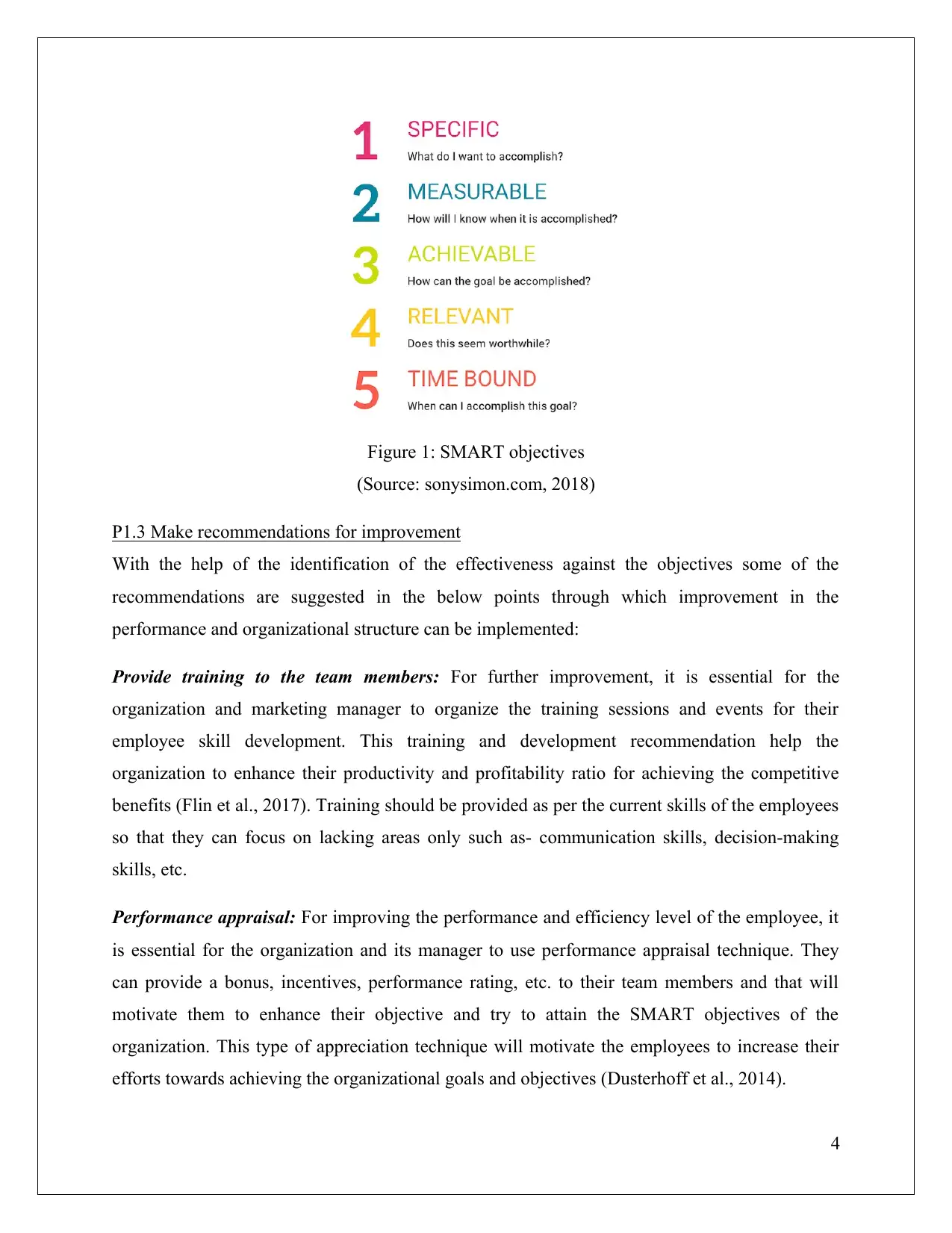
Figure 1: SMART objectives
(Source: sonysimon.com, 2018)
P1.3 Make recommendations for improvement
With the help of the identification of the effectiveness against the objectives some of the
recommendations are suggested in the below points through which improvement in the
performance and organizational structure can be implemented:
Provide training to the team members: For further improvement, it is essential for the
organization and marketing manager to organize the training sessions and events for their
employee skill development. This training and development recommendation help the
organization to enhance their productivity and profitability ratio for achieving the competitive
benefits (Flin et al., 2017). Training should be provided as per the current skills of the employees
so that they can focus on lacking areas only such as- communication skills, decision-making
skills, etc.
Performance appraisal: For improving the performance and efficiency level of the employee, it
is essential for the organization and its manager to use performance appraisal technique. They
can provide a bonus, incentives, performance rating, etc. to their team members and that will
motivate them to enhance their objective and try to attain the SMART objectives of the
organization. This type of appreciation technique will motivate the employees to increase their
efforts towards achieving the organizational goals and objectives (Dusterhoff et al., 2014).
4
(Source: sonysimon.com, 2018)
P1.3 Make recommendations for improvement
With the help of the identification of the effectiveness against the objectives some of the
recommendations are suggested in the below points through which improvement in the
performance and organizational structure can be implemented:
Provide training to the team members: For further improvement, it is essential for the
organization and marketing manager to organize the training sessions and events for their
employee skill development. This training and development recommendation help the
organization to enhance their productivity and profitability ratio for achieving the competitive
benefits (Flin et al., 2017). Training should be provided as per the current skills of the employees
so that they can focus on lacking areas only such as- communication skills, decision-making
skills, etc.
Performance appraisal: For improving the performance and efficiency level of the employee, it
is essential for the organization and its manager to use performance appraisal technique. They
can provide a bonus, incentives, performance rating, etc. to their team members and that will
motivate them to enhance their objective and try to attain the SMART objectives of the
organization. This type of appreciation technique will motivate the employees to increase their
efforts towards achieving the organizational goals and objectives (Dusterhoff et al., 2014).
4
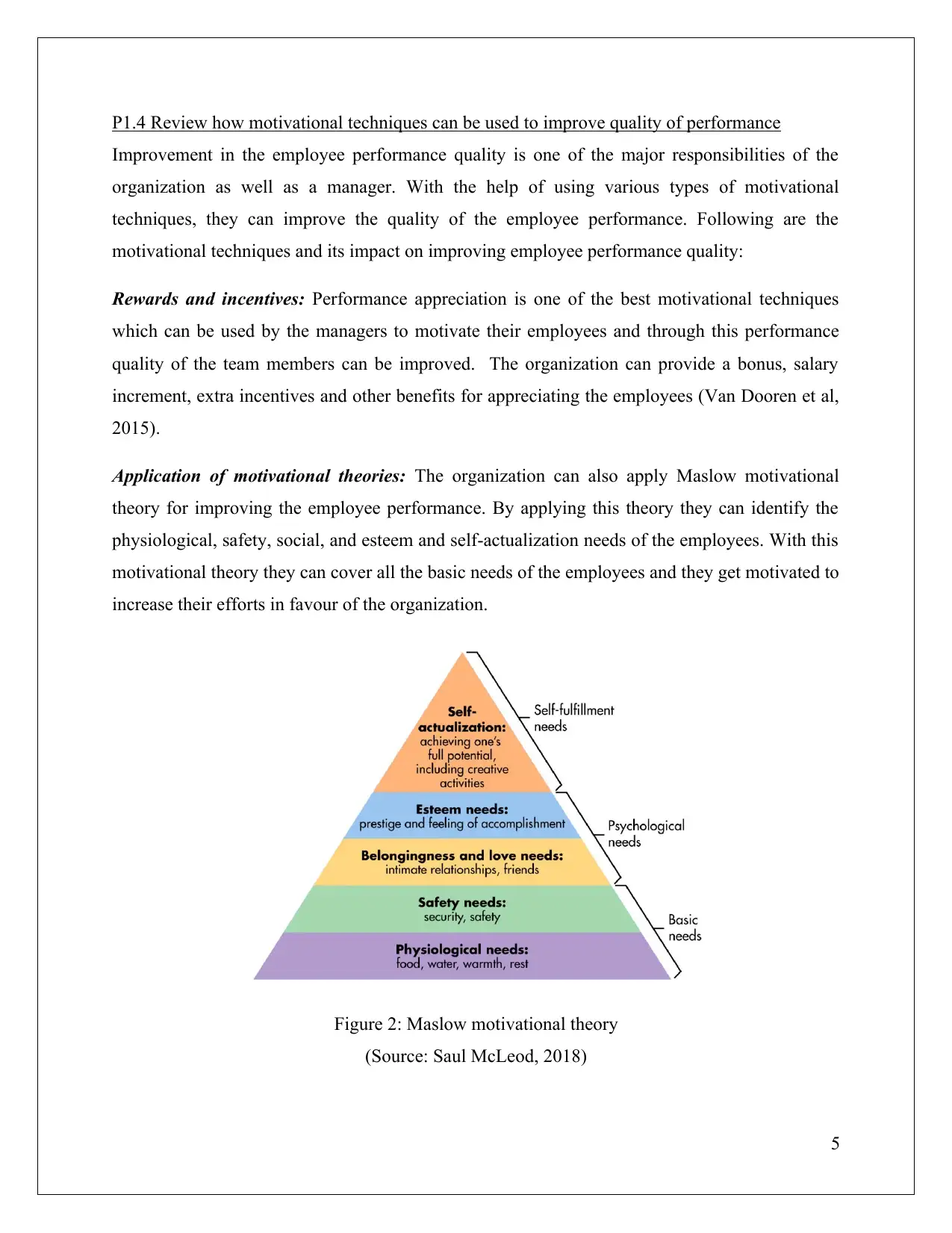
P1.4 Review how motivational techniques can be used to improve quality of performance
Improvement in the employee performance quality is one of the major responsibilities of the
organization as well as a manager. With the help of using various types of motivational
techniques, they can improve the quality of the employee performance. Following are the
motivational techniques and its impact on improving employee performance quality:
Rewards and incentives: Performance appreciation is one of the best motivational techniques
which can be used by the managers to motivate their employees and through this performance
quality of the team members can be improved. The organization can provide a bonus, salary
increment, extra incentives and other benefits for appreciating the employees (Van Dooren et al,
2015).
Application of motivational theories: The organization can also apply Maslow motivational
theory for improving the employee performance. By applying this theory they can identify the
physiological, safety, social, and esteem and self-actualization needs of the employees. With this
motivational theory they can cover all the basic needs of the employees and they get motivated to
increase their efforts in favour of the organization.
Figure 2: Maslow motivational theory
(Source: Saul McLeod, 2018)
5
Improvement in the employee performance quality is one of the major responsibilities of the
organization as well as a manager. With the help of using various types of motivational
techniques, they can improve the quality of the employee performance. Following are the
motivational techniques and its impact on improving employee performance quality:
Rewards and incentives: Performance appreciation is one of the best motivational techniques
which can be used by the managers to motivate their employees and through this performance
quality of the team members can be improved. The organization can provide a bonus, salary
increment, extra incentives and other benefits for appreciating the employees (Van Dooren et al,
2015).
Application of motivational theories: The organization can also apply Maslow motivational
theory for improving the employee performance. By applying this theory they can identify the
physiological, safety, social, and esteem and self-actualization needs of the employees. With this
motivational theory they can cover all the basic needs of the employees and they get motivated to
increase their efforts in favour of the organization.
Figure 2: Maslow motivational theory
(Source: Saul McLeod, 2018)
5
⊘ This is a preview!⊘
Do you want full access?
Subscribe today to unlock all pages.

Trusted by 1+ million students worldwide
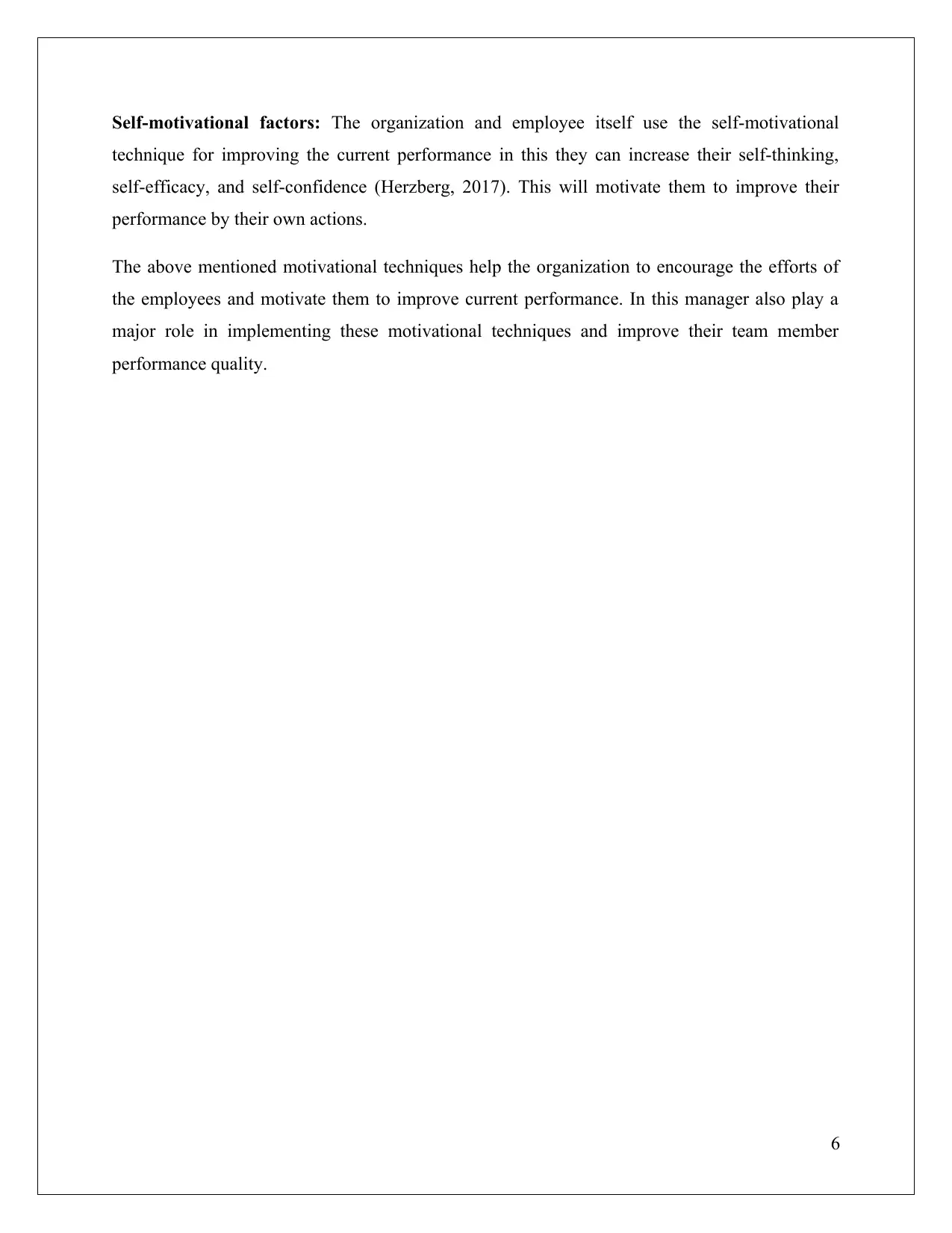
Self-motivational factors: The organization and employee itself use the self-motivational
technique for improving the current performance in this they can increase their self-thinking,
self-efficacy, and self-confidence (Herzberg, 2017). This will motivate them to improve their
performance by their own actions.
The above mentioned motivational techniques help the organization to encourage the efforts of
the employees and motivate them to improve current performance. In this manager also play a
major role in implementing these motivational techniques and improve their team member
performance quality.
6
technique for improving the current performance in this they can increase their self-thinking,
self-efficacy, and self-confidence (Herzberg, 2017). This will motivate them to improve their
performance by their own actions.
The above mentioned motivational techniques help the organization to encourage the efforts of
the employees and motivate them to improve current performance. In this manager also play a
major role in implementing these motivational techniques and improve their team member
performance quality.
6
Paraphrase This Document
Need a fresh take? Get an instant paraphrase of this document with our AI Paraphraser
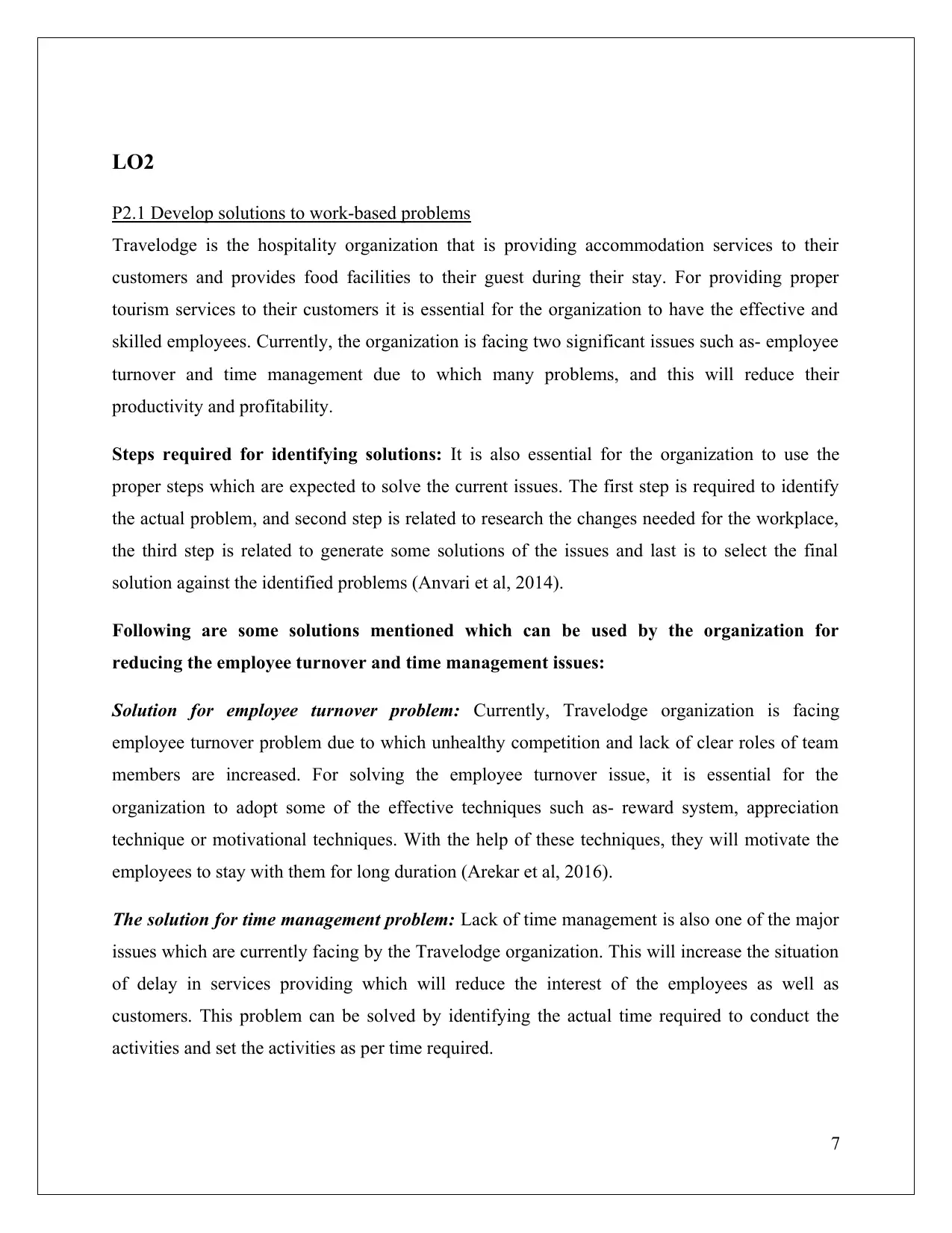
LO2
P2.1 Develop solutions to work-based problems
Travelodge is the hospitality organization that is providing accommodation services to their
customers and provides food facilities to their guest during their stay. For providing proper
tourism services to their customers it is essential for the organization to have the effective and
skilled employees. Currently, the organization is facing two significant issues such as- employee
turnover and time management due to which many problems, and this will reduce their
productivity and profitability.
Steps required for identifying solutions: It is also essential for the organization to use the
proper steps which are expected to solve the current issues. The first step is required to identify
the actual problem, and second step is related to research the changes needed for the workplace,
the third step is related to generate some solutions of the issues and last is to select the final
solution against the identified problems (Anvari et al, 2014).
Following are some solutions mentioned which can be used by the organization for
reducing the employee turnover and time management issues:
Solution for employee turnover problem: Currently, Travelodge organization is facing
employee turnover problem due to which unhealthy competition and lack of clear roles of team
members are increased. For solving the employee turnover issue, it is essential for the
organization to adopt some of the effective techniques such as- reward system, appreciation
technique or motivational techniques. With the help of these techniques, they will motivate the
employees to stay with them for long duration (Arekar et al, 2016).
The solution for time management problem: Lack of time management is also one of the major
issues which are currently facing by the Travelodge organization. This will increase the situation
of delay in services providing which will reduce the interest of the employees as well as
customers. This problem can be solved by identifying the actual time required to conduct the
activities and set the activities as per time required.
7
P2.1 Develop solutions to work-based problems
Travelodge is the hospitality organization that is providing accommodation services to their
customers and provides food facilities to their guest during their stay. For providing proper
tourism services to their customers it is essential for the organization to have the effective and
skilled employees. Currently, the organization is facing two significant issues such as- employee
turnover and time management due to which many problems, and this will reduce their
productivity and profitability.
Steps required for identifying solutions: It is also essential for the organization to use the
proper steps which are expected to solve the current issues. The first step is required to identify
the actual problem, and second step is related to research the changes needed for the workplace,
the third step is related to generate some solutions of the issues and last is to select the final
solution against the identified problems (Anvari et al, 2014).
Following are some solutions mentioned which can be used by the organization for
reducing the employee turnover and time management issues:
Solution for employee turnover problem: Currently, Travelodge organization is facing
employee turnover problem due to which unhealthy competition and lack of clear roles of team
members are increased. For solving the employee turnover issue, it is essential for the
organization to adopt some of the effective techniques such as- reward system, appreciation
technique or motivational techniques. With the help of these techniques, they will motivate the
employees to stay with them for long duration (Arekar et al, 2016).
The solution for time management problem: Lack of time management is also one of the major
issues which are currently facing by the Travelodge organization. This will increase the situation
of delay in services providing which will reduce the interest of the employees as well as
customers. This problem can be solved by identifying the actual time required to conduct the
activities and set the activities as per time required.
7
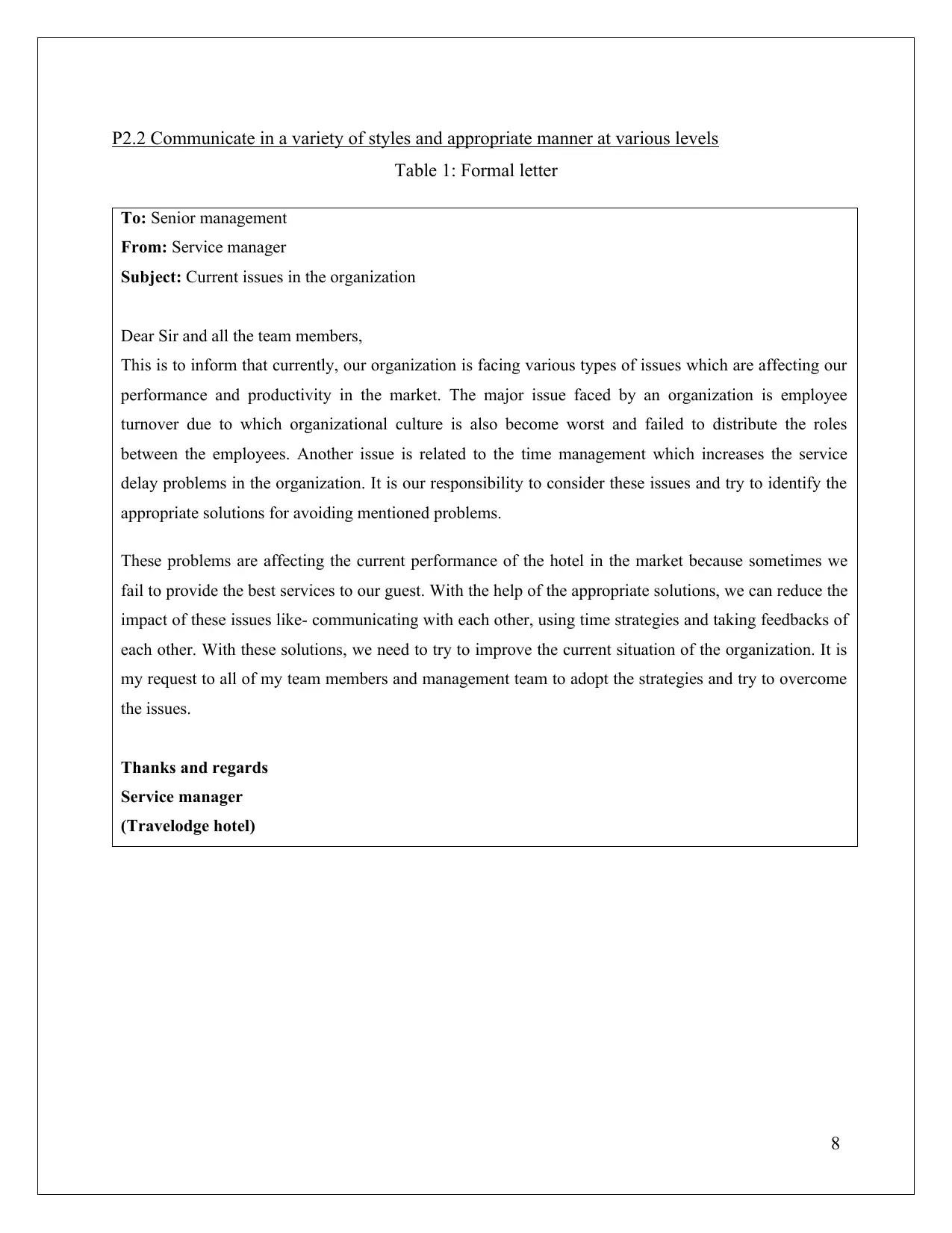
P2.2 Communicate in a variety of styles and appropriate manner at various levels
Table 1: Formal letter
To: Senior management
From: Service manager
Subject: Current issues in the organization
Dear Sir and all the team members,
This is to inform that currently, our organization is facing various types of issues which are affecting our
performance and productivity in the market. The major issue faced by an organization is employee
turnover due to which organizational culture is also become worst and failed to distribute the roles
between the employees. Another issue is related to the time management which increases the service
delay problems in the organization. It is our responsibility to consider these issues and try to identify the
appropriate solutions for avoiding mentioned problems.
These problems are affecting the current performance of the hotel in the market because sometimes we
fail to provide the best services to our guest. With the help of the appropriate solutions, we can reduce the
impact of these issues like- communicating with each other, using time strategies and taking feedbacks of
each other. With these solutions, we need to try to improve the current situation of the organization. It is
my request to all of my team members and management team to adopt the strategies and try to overcome
the issues.
Thanks and regards
Service manager
(Travelodge hotel)
8
Table 1: Formal letter
To: Senior management
From: Service manager
Subject: Current issues in the organization
Dear Sir and all the team members,
This is to inform that currently, our organization is facing various types of issues which are affecting our
performance and productivity in the market. The major issue faced by an organization is employee
turnover due to which organizational culture is also become worst and failed to distribute the roles
between the employees. Another issue is related to the time management which increases the service
delay problems in the organization. It is our responsibility to consider these issues and try to identify the
appropriate solutions for avoiding mentioned problems.
These problems are affecting the current performance of the hotel in the market because sometimes we
fail to provide the best services to our guest. With the help of the appropriate solutions, we can reduce the
impact of these issues like- communicating with each other, using time strategies and taking feedbacks of
each other. With these solutions, we need to try to improve the current situation of the organization. It is
my request to all of my team members and management team to adopt the strategies and try to overcome
the issues.
Thanks and regards
Service manager
(Travelodge hotel)
8
⊘ This is a preview!⊘
Do you want full access?
Subscribe today to unlock all pages.

Trusted by 1+ million students worldwide
1 out of 24
Related Documents
Your All-in-One AI-Powered Toolkit for Academic Success.
+13062052269
info@desklib.com
Available 24*7 on WhatsApp / Email
![[object Object]](/_next/static/media/star-bottom.7253800d.svg)
Unlock your academic potential
Copyright © 2020–2025 A2Z Services. All Rights Reserved. Developed and managed by ZUCOL.



